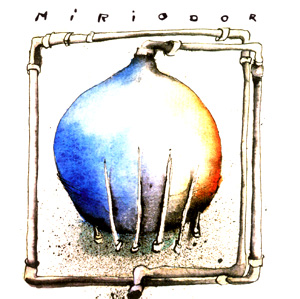|
|
|
01 |
Regards |
|
|
|
06:33 |
|
|
02 |
Spiral |
|
|
|
05:18 |
|
|
03 |
Funeral March |
|
|
|
01:45 |
|
|
04 |
Valence |
|
|
|
04:44 |
|
|
05 |
Trap |
|
|
|
03:24 |
|
|
06 |
Suspicion |
|
|
|
05:16 |
|
|
07 |
Premonitory Insomnia |
|
|
|
06:03 |
|
|
08 |
Network |
|
|
|
03:51 |
|
|
09 |
Waiting For Remi |
|
|
|
04:54 |
|
|
10 |
Full Moon |
|
|
|
03:40 |
|
|
11 |
Suspicion |
|
|
|
07:34 |
|
|
12 |
Oriflamme |
|
|
|
05:30 |
|
|
13 |
Nocturnal Procession |
|
|
|
06:04 |
|
|
14 |
Middle Ages |
|
|
|
08:45 |
|
|
|
| Country |
Canada |
| Spars |
DDD |
| Sound |
Stereo |
|
|
|
Pascal Globensky (piano, synthesizers), Francois Emond (violin, synthesizers), Sabin Hudon (saxophones, synthesizers, percussions), Remi Leclerc (percussions, synthesizers, sequences)
Recorded in Montreal, in 1986 and 1988
Canada's Miriodor brings to mind many of the early '70s Euro-Rock groups, and direct comparisons can be made to the legendary Super Group, Van Der Graaf Generator, mainly because of their use of saxophone and similar dynamic/complex themes. On this, their second release, the group have trimmed themselves to a trio, consisting of assorted keyboards, saxophone, and percussion. However, through their extensive use of MIDI-techniques, this recording seldom hints at the fact that this is merely a trio, instead conveying an amazingly dense and richly-textured soundfield. One aspect of the recording that should be noted is the fact that it was recorded live, directly onto half-track tape, and released without any studio edits! Instrumentally, the keyboardist uses unorthodox methods, and creates a < wavering > effect throughout (which should cause a fair number of audiophiles to run to their tables and check its pitch stability). The percussion used can be likened to that of other progressive ensembles (Gong, Bruford), and it ensures a firm, sure, and steady approach. The performance of Miriodor's saxophonist is one of the many high points of the album, as he plays in a more-or-less straight-ahead style, just and beautiful, and managed to renew my interest in an instrument that, when used in this context, I otherwise find barely tolerable. Power-breaks (ala Van Der Graaf) are carried out with precision, and add a dynamic element that thoroughly contrasts with the album's softer moments. The use of intricate patterns is presented without overbearing pomposity (in spite of Miriodor's three members being as competent as any musicians you're likely to find) and although this is not a < concept > work per se, there is a sense of < sameness > to its entirety. The sound on Miriodor is wonderful, open, and smooth. During complex passages, the images remain intact and are easily distinguished, and there is a nice sense of air surrounding the instruments. Miriodor is sure to please even the most critical listener.
- Glenn Hammett, Sounds like: , no. 6
